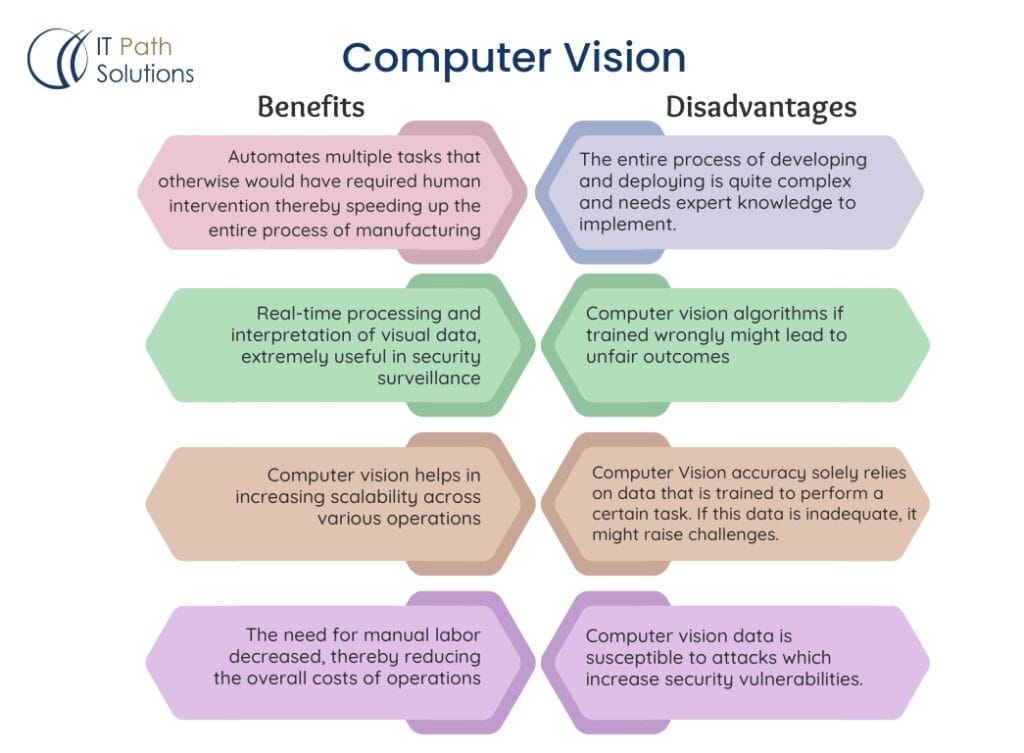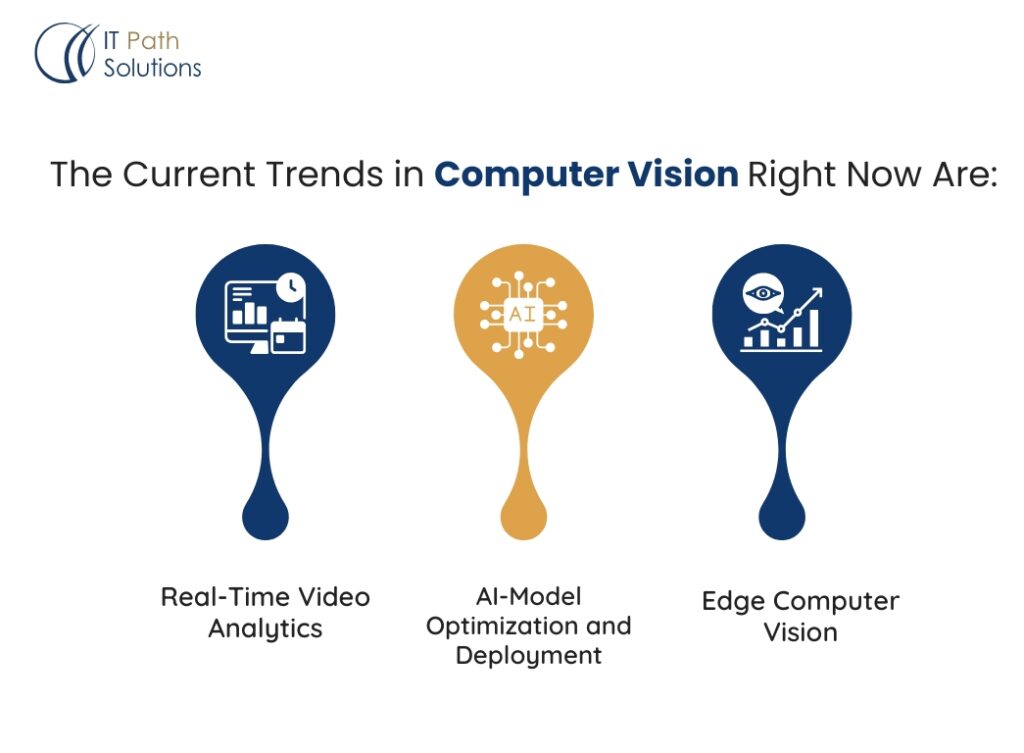What is Computer Vision : A Comprehensive Guide
Keyur Patel
September 12, 2025
8 min
Computer Vision is a segment of Artificial intelligence that uses Machine Learning and Neural networks to train computers and systems to interpret and analyze like human beings. This cutting-edge technology has become so popular that many of us interact with it daily, often without realizing that Computer Vision is powering these experiences.
Let us explain how we have been using Computer Vision (CV) unknowingly through this example:
Have you ever checked out of a retail store without standing in a line? Or, have you accessed your corporate premises through facial recognition? Chances are, you all might have. These are just some basic examples of how and where computer vision is seamlessly integrated into our lives. However, the advanced application of CV goes beyond imagination.
Today, computer vision can extract meaningful information from digital images and videos and perform tasks that surpass human capabilities. By using advanced deep learning algorithms and convolutional neural networks, Computer Vision serves a wide range of industries, from automotive to manufacturing to achieve a great deal of tasks.
In this article, we will go through the Computer Vision system in detail and understand how it works and its application across different segments.
How does Computer Vision Work?
Computer Vision Solutions relies heavily on vast amounts of data. It processes and analyzes the data over specified aspects, identifies patterns, recognizes images, and shows results.
Image acquisition —> Capturing visual data through cameras and videos→ Data preprocessing (normalization, noise reduction, conversion to grayscale, etc) → feature extraction→ object detection/Image segmentation.
Convolutional Neural Networks (CNN) are commonly used to classify and recognize objects in the images correctly. Once the data is analyzed, it can be used to make decisions or perform actions, as required.
A CNN is particularly useful for breaking down images into pixels and tagging them. These labels are further used for performing mathematical predictions and image-seeing.
The neural network goes through each convolutional and checks for the accuracy of the predictions. The neural network runs multiple times until the predictions start falling in place and the model can understand images.
The history of Computer Vision:

The topic of Computer Vision is almost 60 years old, but its true evolution has just begun. For decades, scientists have been trying to experiment with ways in which they can help machines understand visual data.
The origin of Computer Vision goes back to the time when two Swedish scientists, Hubel, and Weisel, placed a range of images in front of a cat and attempted to correlate images with its brain using an electrode in the cat’s visual cortex.
The experiment was successful initially, only capable of identifying simple shapes like straight edges.
Also, during the same time, the first computer image scanning technology was developed to help acquire images.
Slowly and gradually, over the years, advancements were made and various milestones were achieved. From simple images to two-dimensional images to three-dimensional images, more sophisticated algorithms were developed.
Also during the 1960s, Artificial Intelligence emerged as a topic of study, followed by optical Character Recognition (OCR) in 1974. The development was further followed, leading to the emergence of Intelligent Character Recognition (ICR) and advanced algorithms.
Later in 1982, neuroscientist David Marr proposed a hierarchy of processes in which vision works, starting with edge detection, corners, curves, etc. Similarly, Kunihiko Fukushima included convolutional layers in neural networks and so on.
It was in 2001 when a real-time face recognition application was developed and the rest is history.
Computer Vision then shifted to more complex topics, such as:
- Object identification;
- Facial recognition;
- Image segmentation;
- Image classification;
These advancements paved the way for modern applications that continue to transform industries today.
Key Aspects of Computer Vision:
Image Recognition:
Image recognition is a process of identifying an object, image, or action in a digital image captured by the cameras. For example, computer vision understands classes and labels them in the following manner, trees, planes, and buildings.
Object Detection:
A computer vision task of recognizing multiple objects within an image and marking them with a specific symbol. It is widely used in industrial and manufacturing processes to control and monitor production lines.
Image Segmentation:
It is a computer vision algorithm that divides the object into multiple segments based on pixels to extract more meaningful data to analyze. The analyzed object has a bounding box identified with an ID.
Facial Recognition:
The system identifies a person from an image or a video.
Motion Analysis:
This involves understanding the motion of moving objects in a video, widely used in security, surveillance, and sports.
Machine Vision:
It combines Computer Vision and Robotics to process visual data and control hardware movements in the application.
Benefits of Computer Vision:
Let us now look at the benefits and disadvantages of computer vision applicable across various industries.

Computer Vision Tools and Libraries:
To implement Computer Vision in your organization, you can use several tools and libraries namely:
OpenCV:
OpenCV is a very popular and reliable library used for computer vision.
TensorFlow and PyTorch:
TensorFlow: Advanced and Sophisticated frameworks for deep learning applications
MATLAB Image Processing Toolbox:
You can access a comprehensive suite of reference-standard algorithms and tools for image processing, analysis, and visualization.
Current Trends In Computer Vision:
The popularity of Computer Vision is increasing rapidly. With the advent of Edge Computing, the technology is becoming more accessible and scalable, making it possible to deploy Computer Vision applications across virtually any industry. This combination of technologies is making way for real-time processing and analysis, expanding the potential for innovation in countless sectors.

Real-time Video Analytics:
From traditional to modern cameras, video analytics has come a long way. With the advent of modern deep learning, special cameras can now analyze video streams to deliver advanced video analytics.
AI-Model Optimization and Deployment:
Over the years, AI models have evolved and it is now possible to have low-sized machine learning models with increased computational efficiency. This helps in implementing deep learning computer vision without being dependent on expensive and energy-consuming AI hardware.
Edge Computer Vision:
Until now, Computer Vision and AI development were only possible with cloud solutions. Engineers had to update all the images and data on the cloud directly, often using various computer vision APIs (AWS Rekognition, Google Vision API, etc.)
This made it extremely difficult for engineers to offload data while also maintaining privacy and managing the cost.
However, with Edge AI, data can now be processed locally. Edge AI or Edge Intelligence uses edge computing and the Internet of Things to store data with ease, reducing the reliance on cloud-based infrastructure.
How is Computer Vision Used? What are the Applications of Computer Vision?
Computer Vision is used across multiple industries day in and day out. Here are a few examples of how computer vision can be used in various industries.
Healthcare:
Computer Vision applications help in medical imaging such as X-rays, CT-Scan, and MRI, Cancer detection, Blood loss measurement, digital pathology, movement analysis, and more.
The scans can be used to identify diseases like pneumonia and cancer. The real-time analysis drastically improves healthcare outcomes.
Transportation:
Self-driving cars, what once looked like a dream, is now an achievement. Numerous automobile engineers are testing the systems to develop self-driving cars that can classify and detect objects on the road. With the use of sensors and cameras, and advanced techniques such as pattern recognition, feature extraction, and object tracking, it is now possible to have an automatic driving car.
Computer Vision can detect and locate pedestrians walking along the road.
Next, computer vision is also used in parking lot occupancy detection in the Parking Guidance and Information System. With the advancement in CNN, it is now possible to detect vehicles with accuracy even in extreme weather conditions and with less lighting.
Advanced computer Vision algorithms can accurately track and detect traffic at an intersection improving road safety.
Computer vision algorithms can also be trained to detect cracks and edges on a road.
Manufacturing:
Computer Vision is widely used in the manufacturing industry for automating multiple quality control tasks. One can use camera-based vision inspection systems to collect real-time data and detect defects in the goods.
Also, 3D vision systems can be used for efficient inspection in the production line.
Financial Services:
A new innovative way to automate document processing, document verification, and extraction is by using computer vision. CV algorithms can be trained to extract relevant information from documents while also ensuring data compliance.
One can also use CV for document authentication by analyzing visual features like watermarks, logos, and holograms.
Retail and eCommerce:
Computer vision in retail can drastically transform how the retail industry functions. It enables inventory management, by keeping track of stock items etc.
For example, the Amazon Go store has streamlined the customer shopping experience by using computer vision.
Drive change and foster innovation using Computer Vision:
Computer vision is a vast field and modern & innovative field with immense potential. However, its implementation might become overwhelming for you to harness its full potential. That’s where we come in. Let us help you leverage the power of computer vision in your quality systems and inspection lines. IT Path Solutions is here to make computer vision more accessible to your business and empower you with CV tools.
Keyur Patel
Co-Founder
Keyur Patel is the director at IT Path Solutions, where he helps businesses develop scalable applications. With his extensive experience and visionary approach, he leads the team to create futuristic solutions. Keyur Patel has exceptional leadership skills and technical expertise in Node.js, .Net, React.js, AI/ML, and PHP frameworks. His dedication to driving digital transformation makes him an invaluable asset to the company.
Get in Touch
Search
Blog Categories


